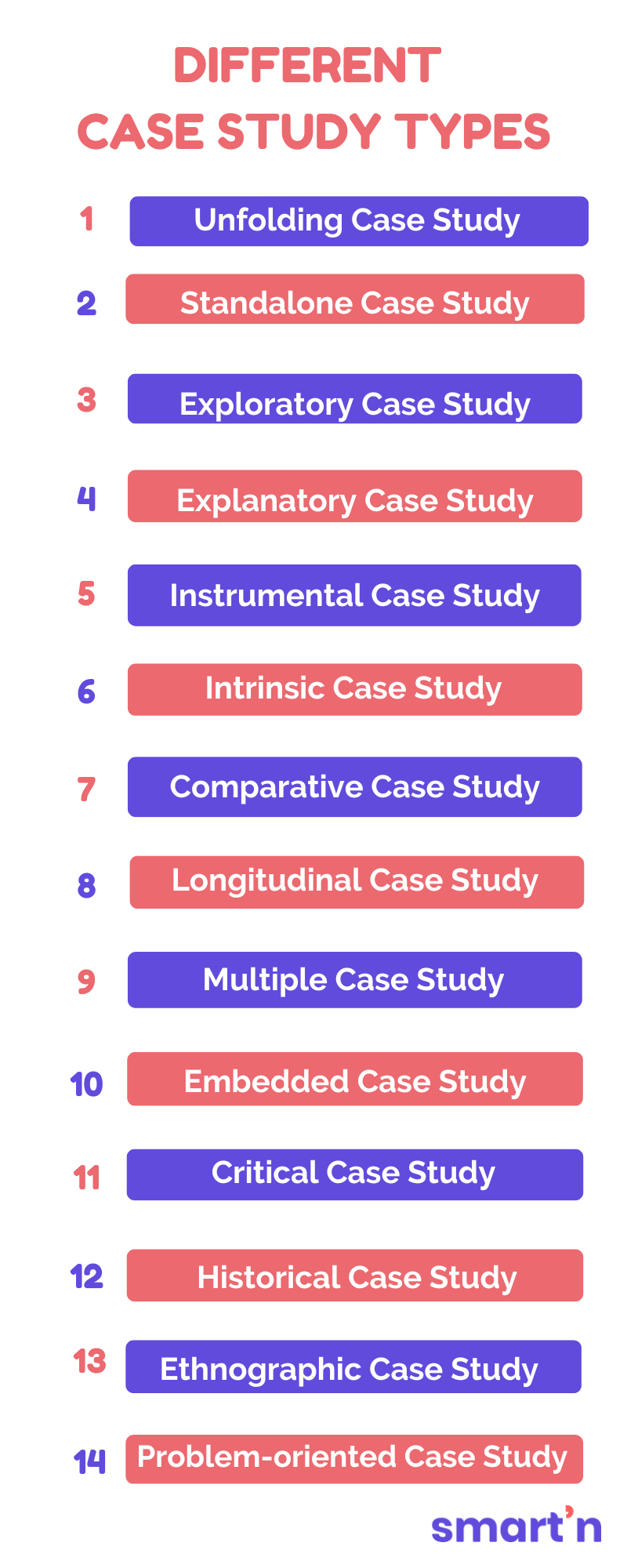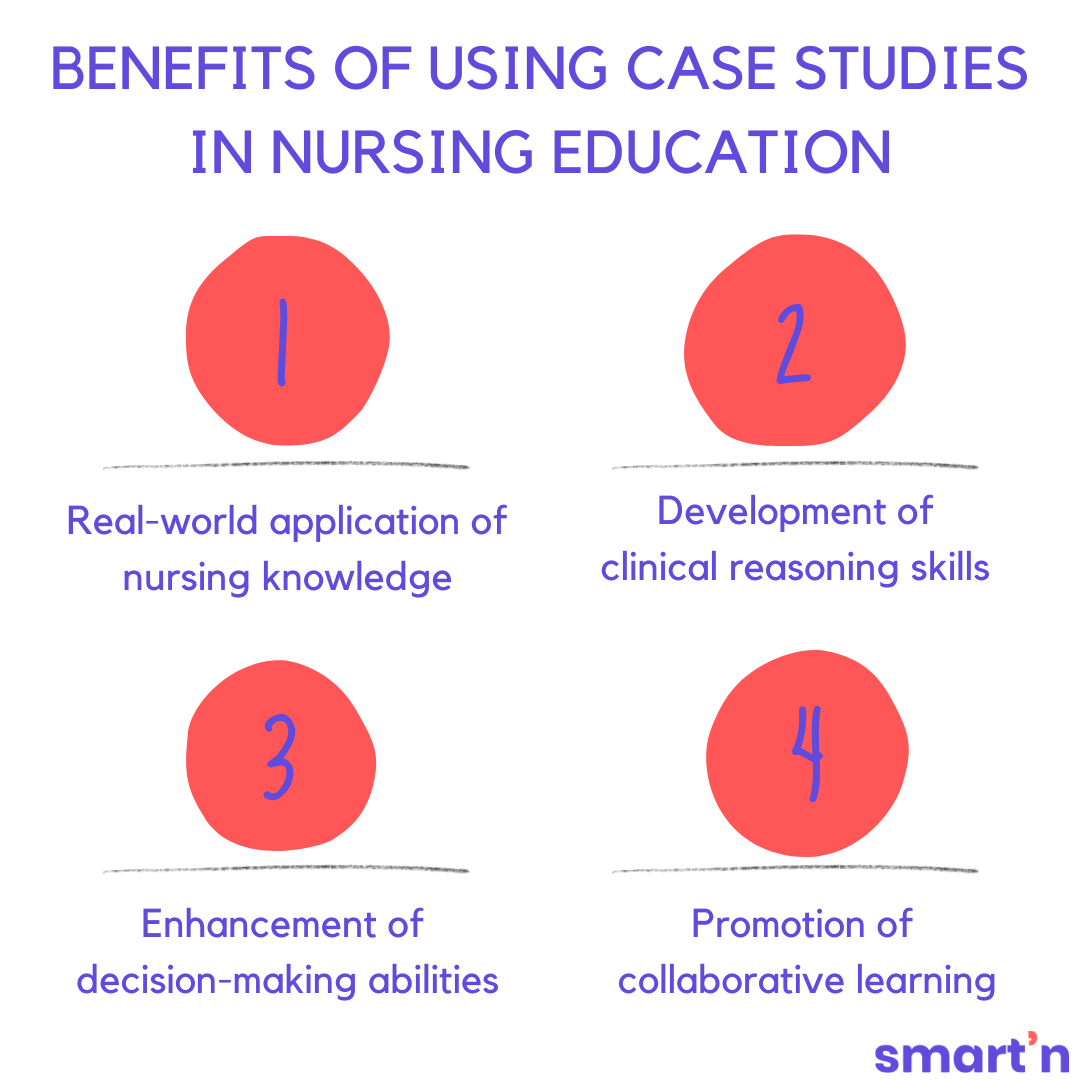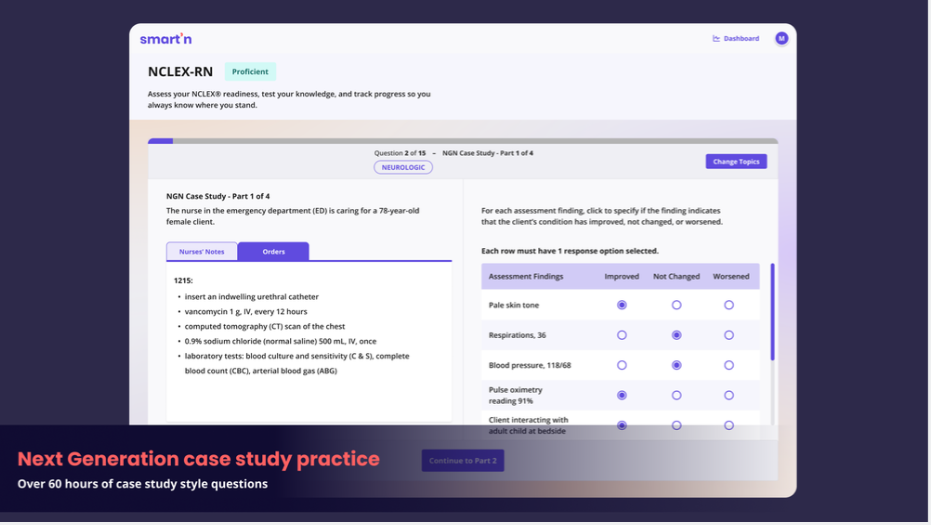Understanding The Different Types Of Case Studies In 2023
Case studies are an invaluable tool for researchers and students across various disciplines, providing a real-world perspective and allowing them to apply theoretical concepts to practical scenarios.
In this blog, we will delve into various case study types, ranging from exploratory to descriptive, explanatory, and more. Join us as we unlock the insights and nuances of various case study methodologies, uncover their unique features, and highlight their significance in today's ever-evolving landscape.
If you're a nursing student looking to enhance your clinical skills and knowledge, nursing case studies are an invaluable tool. They offer a real-world perspective to researchers and students, allowing them to apply theoretical concepts to practical scenarios.
Whether you're a seasoned researcher or a nurse student getting ready for your nursing license exam, this blog will provide you with valuable insights into the diverse world of case studies in 2023. So let's dive in.
Different case study types
Case studies are research methods used in various fields, such as business, social sciences, healthcare, and more, to investigate and analyze a particular subject or phenomenon. There are several types of case studies, each with its own unique characteristics and purposes. Here are some common case study types:
1. Unfolding Case Study
The first and most common case study type is the unfolding one. An unfolding case study is a dynamic, multi-faceted scenario that gradually reveals information and unfolds over time, presenting a complex situation for analysis and decision-making.
It is designed to simulate real-world situations and challenges that professionals may encounter in their field of practice. Unfolding case studies typically present information in a sequential and progressive manner, allowing learners to actively engage with the evolving scenario and make decisions based on the information provided.
As the case study progresses, new information and challenges may arise, requiring learners to adapt their approaches and strategies. Unfolding case studies are often used to promote critical thinking skills, clinical reasoning, and problem-solving abilities in professional and clinical settings.
2. Standalone or Descriptive Case Study
A descriptive case study, also known as a standalone case study, on the other hand, is a self-contained, static scenario that provides a comprehensive overview of a specific issue, problem, or situation.
It typically includes a detailed description of the case, relevant background information, and relevant data or facts for analysis. Descriptive case studies do not evolve over time and are presented in their entirety upfront, without any new information or challenges being introduced during the learning process. Learners are expected to analyze the given information and apply their critical thinking skills and knowledge to make decisions or recommendations based on the case study.
This case study type is commonly used in academic settings for teaching and learning purposes, as it allows learners to apply theoretical concepts to real-world situations and develop problem-solving skills.
3. Exploratory Case Study
An exploratory case study is like the unfolding case study type, used when the researcher wants to investigate a new or understudied area. It involves conducting preliminary research to gather information and generate hypotheses or research questions about the case. Exploratory case studies are often used to identify potential variables, factors, or relationships that can be further investigated in future research.
4. Explanatory Case Study
An explanatory case study aims to understand the cause-and-effect relationships between variables or factors in a particular case. It involves investigating the underlying reasons or mechanisms that explain why certain events or outcomes occurred. Explanatory case studies are often used to test hypotheses or theories and establish causal relationships.
5. Instrumental Case Study
In an instrumental case study, the researcher selects a case that is considered typical or representative of a larger population or phenomenon.
The instrumental case study purpose is not to understand the case itself but to use it as a means to gain insights into a broader phenomenon. Instrumental case studies are often used to generalize findings to a larger population or to support the validity of a theory or model.
6. Intrinsic Case Study
In an intrinsic case study, the case itself is of particular interest, and the researcher aims to understand the unique characteristics, behaviors, or experiences of the case.
The focus of an intrinsic case study is not on generalizing findings to a larger population, but on gaining an in-depth understanding of the case itself. Intrinsic case studies are often used in qualitative research to explore complex and unique phenomena.
7. Comparative Case Study
A comparative case study involves comparing two or more cases to identify similarities and differences between them. It aims to understand the variations in outcomes, behaviors, or characteristics among cases and identify factors or variables that may explain the differences.
Comparative case studies are often used to analyze multiple cases in a specific context, such as different organizations, countries, or time periods.
8. Longitudinal Case Study
A longitudinal case study involves studying a case over an extended period of time to observe changes, developments, or trends over time. It requires collecting data at multiple time points to analyze how the case evolves or changes over time.
You can often see examples of case studies of this type in investigating processes, patterns, or trends that occur over time, such as organizational changes, social developments, or individual behaviors.
9. Multiple Case Study
Here is another common case study type. A multiple case study, also known as a collective case study, involves studying multiple cases within a single research project.
The cases may be similar or different, and they are analyzed collectively to identify patterns, trends, or commonalities among them. Multiple case studies are often used to compare and contrast cases, validate findings across cases, or provide a broader understanding of a phenomenon by examining it from multiple perspectives.
10. Embedded Case Study
An embedded case study involves studying a specific case within a larger context or setting. The focus is on understanding the dynamics, interactions, and relationships between the case and its broader environment. Embedded case studies are often used to investigate how a case is influenced by its context or how it influences the context in which it is embedded.
11. Critical Case Study
A critical case study involves studying an extreme or unique case that challenges or confirms existing theories, assumptions, or beliefs. The purpose is to provide a critical examination of a particular phenomenon or challenge existing knowledge. This case study type is often used to explore rare or unusual cases that can shed new light on a topic or challenge established theories.
12. Historical Case Study
A historical case study involves studying a past event, era, or phenomenon to understand its historical context, significance, and implications. It often involves case analysis of historical documents, records, and artifacts to reconstruct the past and draw insights from historical events.
Historical case studies are often used in fields such as history, archaeology, and cultural studies to explore the past and its relevance to the present.
13. Ethnographic Case Study
An ethnographic case study involves conducting in-depth observations and analysis of a particular culture, group, or community to understand their customs, beliefs, behaviors, and social dynamics.
It often involves living among the participants and immersing oneself in their culture or community to gain a deep understanding of their way of life. Ethnographic case studies are often used in anthropology, sociology, and cultural studies to explore and describe different cultures and social groups.
14. Problem-oriented Case Study
Here is the last case study type on our list. A problem-oriented case study involves studying a specific problem or challenge in depth, with the goal of understanding its causes, effects, and possible solutions.
The case study may involve investigating real-world issues, such as environmental problems, social issues, or organizational challenges, and it often requires a multidisciplinary approach to problem-solving.
This type of case study is often used in fields such as nursing, environmental science, public policy, or management to understand and address complex problems.
These are some common case study types, each with its own features. The choice of case study type depends on the research questions, objectives, and context of the study. Researchers need to carefully understand the case study definition of different types and examine different case study examples to carefully choose the most appropriate types of case studies for their research design.
Benefits of using case studies in nursing education
There are different case study types, each offering so many benefits to students and researchers of all fields. The use of case studies, in nursing education offers several benefits as well. Here are some of the most significant benefits:
1. Real-world application of nursing knowledge:
Case studies provide students with the opportunity to apply their theoretical knowledge to real-world scenarios. This helps them understand how nursing concepts and principles are applied in clinical settings, preparing them for their future nursing practice. Case studies allow students to see the practical implications of their learning, helping them bridge the gap between theory and practice.
2. Development of clinical reasoning skills:
Case studies require students to analyze complex patient scenarios, interpret data, and make clinical judgments. This helps them develop critical thinking and clinical reasoning skills, which are essential for providing safe and effective patient care. Through case studies, students learn to collect and analyze data, identify relevant information, and develop appropriate nursing interventions.
3. Enhancement of decision-making abilities:
Case studies challenge students to make decisions based on limited information, similar to what they will encounter in real clinical situations. This helps them develop their decision-making abilities, learn to prioritize patient needs, and make sound nursing judgments. Case studies also expose students to ethical dilemmas, helping them develop ethical decision-making skills and understand the ethical implications of their actions.
4. Promotion of collaborative learning:
Case studies encourage collaboration among nursing students, allowing them to work together in teams to analyze and solve complex patient problems. This promotes active engagement, discussion, and exchange of ideas, leading to enhanced learning. Through collaborative learning, students also develop communication and teamwork skills, which are vital for effective nursing practice in interdisciplinary healthcare settings.
In summary, using case studies in nursing education offers numerous benefits, which contribute to the overall preparation of nursing students for their future roles as competent and compassionate healthcare professionals.
Challenges and tips for using case studies in nursing education
Case studies are widely used in nursing education to promote critical thinking, clinical reasoning, and problem-solving skills among nursing students. However, their effective integration into nursing curricula can present challenges and require careful consideration. Let’s check some challenges and tips to effectively utilize different case study types and get prepared for real-world clinical practice.
Lack of real-world context
To ensure that case studies are realistic and relevant to real-world nursing practice, consider using cases based on actual patient scenarios or incorporating authentic clinical experiences. You can also involve practicing nurses or other healthcare professionals as guest speakers or mentors to provide real-world insights.
Engaging students
To keep students engaged and actively participating in the learning process, consider using interactive and student-centered approaches such as problem-based learning, role-playing, or small group discussions. Incorporate multimedia, visual aids, and other interactive tools to make case studies more dynamic and stimulating.
Time management
To overcome challenges in finding adequate time to incorporate case studies, carefully plan and prioritize the use of case studies within the nursing curriculum. You can select relevant and impactful case studies that align with the learning outcomes and eliminate redundant content. Also, consider integrating case studies across different courses or using them as an ongoing thread throughout the nursing program. Smart’n is a great source, full of different case study types to help nursing students pass their NCLEX exam. Start your membership now and get access to more than 2,500 practice questions and 60+ hours of NGN NCLEX-style nursing case studies.
Assessment and evaluation
Assessing student learning from case studies can be complex. Consider using a rubric that includes criteria for evaluating not only knowledge but also critical thinking, clinical reasoning, and decision-making skills. Provide clear guidelines and expectations for students, and use formative and summative assessments to provide timely feedback for improvement.
Ethical considerations
To address ethical dilemmas presented in case studies, incorporate discussions on ethical reasoning and decision-making skills into the nursing curriculum. Provide opportunities for students to reflect on ethical issues and engage in ethical discussions with peers and faculty. Encourage students to consider diverse perspectives and apply ethical principles in complex clinical situations.
Multicultural sensitivity
To promote cultural competence, use case study research examples that reflect diverse cultural perspectives and patient populations. Incorporate discussions on cultural awareness, sensitivity, and humility into the case study activities. Encourage students to reflect on their own cultural biases and engage in respectful communication with patients from diverse backgrounds.
Interdisciplinary integration
To promote interdisciplinary integration and collaboration, use case studies that require students to work collaboratively with peers from different healthcare disciplines. Foster an inclusive and collaborative learning environment where students can learn from each other's expertise and perspectives. Incorporate opportunities for interdisciplinary discussions, group projects, or simulations.
Technology and resources
Take advantage of advancements in technology to enhance case study learning. Use digital tools, online resources, and simulation software to create immersive and interactive case study experiences. Provide training and support to both faculty and students to effectively use technology in case study activities.
Faculty development
Provide professional development opportunities for faculty to enhance their knowledge and skills in designing and implementing effective case studies. Offer workshops, seminars, or mentoring programs to help faculty create engaging and relevant sample case study activities.
Collaboration and communication
Use case studies as opportunities to develop teamwork, collaboration, and communication skills among nursing students. Assign students to work in pairs or small groups to analyze and discuss case studies collaboratively. Provide feedback on their teamwork and communication skills and encourage reflection on their collaborative experiences.
By addressing these subheadings, nursing educators can effectively navigate the challenges and leverage the tips to create meaningful and engaging different case study types for nursing students, facilitating their critical thinking, clinical reasoning, ethical decision-making, and interprofessional collaboration skills development, ultimately preparing them for real-world nursing jobs.
Conclusion
In conclusion, understanding the different case study types in 2023 is essential for leveraging their benefits in research and practice. Case studies are powerful tools that may evolve with technology and societal changes. However, conducting high-quality case studies requires careful planning, ethical considerations, and rigorous analysis. By utilizing case studies effectively, you can gain insights, inform decisions, and contribute to positive changes. Staying updated with emerging trends and best practices is crucial as you continue to utilize case studies in your respective fields.
FAQs
1. What are the various types of case studies?
1. Unfolding Case Study
2. Standalone or Descriptive Case Study
3. Exploratory Case Study
4. Explanatory Case Study
5. Instrumental Case Study
6. Intrinsic Case Study
7. Comparative Case Study
8. Longitudinal Case Study
9. Multiple Case Study
10. Embedded Case Study
11. Critical Case Study
12. Historical Case Study
13. Ethnographic Case Study
14. Problem-oriented Case Study
2. What is the most important part of a case study?
The most important part of a case study is the analysis and discussion of the findings, where you interpret the data, draw conclusions, and provide recommendations for future research or actions.




